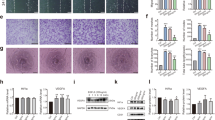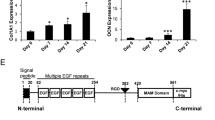Abstract
Angiogenesis plays an important role in bone development and postnatal bone fracture repair. Vascular endothelial growth factor (VEGF) and vascular endothelial growth factor receptors (VEGFRs) are primarily involved in angiogenesis. This study investigated the expression of VEGF isoforms, VEGFR-1, and VEGFR-2 during the osteoblastic differentiation of cultured human periosteal-derived cells. In addition, the effect of exogenous VEGF on the osteoblastic differentiation of cultured human periosteal-derived cells was also examined. The expression of the VEGF isoforms (VEGF121, VEGF165, VEGF189, and VEGF206), VEGFR-1, and VEGFR-2 was observed in the periosteal-derived cells. Administration of KRN633, a VEGFR-1 and VEGFR-2 inhibitor, decreased the alkaline phosphatase (ALP) activity during the osteoblastic differentiation of cultured human periosteal-derived cells. However, the administration of VEGFR2 Kinase Inhibitor IV, a VEGFR-2 inhibitor, did not affect the ALP activity. The addition of recombinant human VEGF165 elevated the ALP activity and increased the calcium content in the periosteal-derived cells. Treating the periosteal-derived cells with recombinant human VEGF165 resulted in an increase in Runx2 transactivation in the periosteal-derived cells. These results suggest that exogenous VEGF stimulates the osteoblastic differentiation of cultured human periosteal-derived cells and VEGF might act as an autocrine growth factor for the osteoblastic differentiation of cultured human periosteal-derived cells.






Similar content being viewed by others
References
Mayer H, Bertram H, Lindenmaier W, Korff T, Weber H, Weich H (2005) Vascular endothelial growth factor (VEGF-A) expression in human mesenchymal stem cells: autocrine and paracrine role on osteoblastic and endothelial differentiation. J Cell Biochem 95:827–839
Nakatsu MN, Sainson RC, Perez-del-Pulgar S, Aoto JN, Aitkenhead M, Taylor KL (2003) VEGF(121) and VEGF(165) regulate blood vessel diameter through vascular endothelial growth factor receptor 2 in an in vitro angiogenesis model. Lab Invest 83:1873–1885
Neufeld G, Cohen T, Gengrinovitch S, Poltorak Z (1999) Vascular endothelial growth factor (VEGF) and its receptors. FASEB J 13:9–22
Chung N, Jee BK, Chae SW, Jeon YW, Lee KH, Rha HK (2009) HOX gene analysis of endothelial cell differentiation in human bone marrow-derived mesenchymal stem cells. Mol Biol Rep 36:227–235
Colnot CI, Helms JA (2001) A molecular analysis of matrix remodeling and angiogenesis during long bone development. Mech Dev 100:245–250
Park BW, Hah YS, Kim DR, Kim JR, Byun JH (2008) Vascular endothelial growth factor expression in cultured periosteal-derived cells. Oral Surg Oral Med Oral Pathol Oral Radiol Endod 105:554–560
Tatsuyama K, Maezawa Y, Baba H, Imamura Y, Fukuda M (2000) Expression of various growth factors for cell proliferation and cytodifferentiation during fracture healing repair of bone. Eur J Histochem 44:269–278
Gerber HP, Vu TH, Ryan AM, Kowalski J, Werb Z, Ferrana N (1999) VEGF couples hypertrophic cartilage remodeling, ossification and angiogenesis during endochondral bone formation. Nat Med 5:623–628
Maes C, Carmeliet P, Moermans K, Stockmans I, Smets N, Collen D, Bouillon R, Carmeliet G (2002) Impaired angiogenesis and endochondral bone formation in mice lacking the vascular endothelial growth factor isoforms VEGF164 and VEGF188. Mech Dev 111:61–73
Park BW, Hah YS, Kim DR, Kim JR, Byun JH (2007) Osteogenic phenotypes and mineralization of cultured human periosteal-derived cells. Arch Oral Biol 52:983–989
Ziros PG, Gil AP, Georgakopoulos T, Habeos I, Kletsas D, Basdra EK, Papavassiliou AG (2002) The bone-specific transcriptional regulator Cbfa1 is a target of mechanical signals in osteoblastic cells. J Biol Chem 277:23934–23941
Papachristou DJ, Papachristou GI, Papaefthimiou OA, Agnantis NJ, Basdra EK, Papavassiliou AG (2005) The MAPK-AP-1/-Runx2 signalling axes are implicated in chondrosarcoma pathobiology either independently or via up-regulation of VEGF. Histopathology 47:565–574
Hansen-Algenstaedt N, Joscheck C, Wolfram L, Schaefer C, Müller I, Böttcher A, Deuretzbacher G, Wiesner L, Leunig M, Algenstaedt P, Rüther W (2006) Sequential changes in vessel formation and micro-vascular function during bone repair. Acta Orthop 77:429–439
Rhee JG, Eddy HA, Hong JJ, Suntharalingam M, Vaupel PW (1996) Divergent changes of flow through individual blood vessels upon localized heating. Int J Hyperthermia 12:757–769
Haigh JJ, Gerber HP, Ferrara N, Wagner EF (2000) Conditional inactivation of VEGF-A in areas of collagen2a1 expression results in embryonic lethality in the heterozygous state. Development 127:1445–1453
Kanczler JM, Oreffo RO (2008) Osteogenesis and angiogenesis: the potential for engineering bone. Eur Cell Mater 15:100–114
Wedge SR, Ogilvie DJ, Dukes M, Kendrew J, Chester R, Jackson JA, Boffey SJ, Valentine PJ, Curwen JO, Musgrove HL, Graham GA, Hughes GD, Thomas AP, Stokes ES, Curry B, Richmond GH, Wadsworth PF, Bigley AL, Hennequin LF (2002) ZD6474 inhibits vascular endothelial growth factor signaling, angiogenesis, and tumor growth following oral administration. Cancer Res 62:4645–4655
Yao Z, Lafage-Proust MH, Plouët J, Bloomfield S, Alexandre C, Vico L (2004) Increase of both angiogenesis and bone mass in response to exercise depends on VEGF. J Bone Miner Res 19:1471–1480
Wang DS, Yamazaki K, Nohtomi K, Shizume K, Ohsumi K, Shibuya M, Demura H, Sato K (1996) Increase of vascular endothelial growth factor mRNA expression by 1,25-dihydroxyvitamin D3 in human osteoblast-like cells. J Bone Miner Res 11:472–479
Deckers MM, Karperien M, van der Bent C, Yamashita T, Papapoulos SE, Löwik CW (2000) Expression of vascular endothelial growth factors and their receptors during osteoblast differentiation. Endocrinology 141:1667–1674
Villars F, Bordenave L, Bareille R, Amedee J (2000) Effect of human endothelial cells on human bone marrow stromal cell phenotype: role of VEGF? J Cell Biochem 79:672–685
Furumatsu T, Shen ZN, Kawai A, Nishida K, Manabe H, Oohashi T, Inoue H, Ninomiya Y (2003) Vascular endothelial growth factor principally acts as the main angiogenic factor in the early stage of human osteoblastogenesis. J Biochem 133:633–639
Midy V, Plouët J (1994) Vasculotropin/vascular endothelial growth factor induces differentiation in cultured osteoblasts. Biochem Biophy Res Commun 199:380–386
Rahimi N (2006) VEGFR-1 and VEGFR-2: two non-identical twins with a unique physiognomy. Front Biosci 11:818–829
Kanno T, Takahashi T, Tsujisawa T, Ariyoshi W, Nishihara T (2007) Mechanical stress-mediated Runx2 activation is dependent on Ras/ERK1/2 MAPK signaling in osteoblasts. J Cell Biochem 101:1266–1277
Nathan SS, Pereira BP, Zhou YF, Gupta A, Dombrowski C, Soong R, Pho RW, Stein GS, Salto-Tellez M, Cool SM, van Wijnen AJ (2009) Elevated expression of Runx2 as a key parameter in the etiology of osteosarcoma. Mol Biol Rep 36:153–158
Li J, Jiang L, Liao G, Chen G, Liu Y, Wang J, Zheng Y, Luo S, Zhao Z (2009) Centrifugal forces within usually-used magnitude elicited a transitory and reversible change in proliferation and gene expression of osteoblastic cells UMR-106. Mol Biol Rep 36:299–305
Thirunavukkarasu K, Pei Y, Moore TL, Wei T, Wang H, Chandrasekhar S (2007) Regulation of NFATc2 gene expression by the transcription factor Runx2. Mol Biol Rep 34:1–10
Porter K, Hossain M, Wang M, Radano CP, Baker GL, Smith MR III, McCabe LR (2006) Regulation of osteoblast gene expression and phenotype by polylactide-fatty acid surfaces. Mol Biol Rep 33:1–12
Acknowledgments
We would like to express our appreciation for providing a p6xOse2-Luc and a Runx2 expression plasmid to Dr. J. B. Kim (Department of Biological Sciences, Seoul National University, Seoul, Republic of Korea). This work was supported by the research promotion fund of the Gyeongsang National University Hospital (2008).
Author information
Authors and Affiliations
Corresponding author
Rights and permissions
About this article
Cite this article
Hah, YS., Jun, JS., Lee, SG. et al. Vascular endothelial growth factor stimulates osteoblastic differentiation of cultured human periosteal-derived cells expressing vascular endothelial growth factor receptors. Mol Biol Rep 38, 1443–1450 (2011). https://doi.org/10.1007/s11033-010-0249-1
Received:
Accepted:
Published:
Issue Date:
DOI: https://doi.org/10.1007/s11033-010-0249-1




